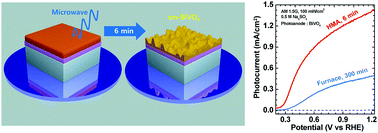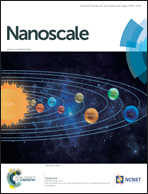Ultrafast fabrication of highly active BiVO4 photoanodes by hybrid microwave annealing for unbiased solar water splitting†
Abstract
Hybrid microwave annealing (HMA) with a silicon susceptor in a household microwave oven produces BiVO4-based photoanodes of much improved performance in photoelectrochemical water oxidation in only 6 min relative to conventional thermal annealing in a traditional muffle furnace (FA) that needs a much longer time, 300 min. This technique can apply equally effectively to bare as well as modified BiVO4 by Mo-doping, heterojunction formation with WO3, and an oxygen evolution co-catalyst. Relative to FA, HMA forms BiVO4 films of smaller feature sizes, higher porosity, and increased three dimensional roughness, which decrease the diffusion distance of holes to the surface and thereby increase mainly the bulk charge separation efficiency (ηbulk) of the photoanodes. Thus, the HMA-treated BiVO4/WO3 film achieves the state-of-the art ηbulk of ∼90% for water oxidation. Combination of a photoanode of NiOOH/FeOOH/BiVO4/WO3 (HMA, 6 min) with a 2p c-Si solar cell allows a solar to hydrogen conversion efficiency of ∼5.0% in unbiased overall water splitting, which is also comparable to the state-of-the-art for a similar material combination.


 Please wait while we load your content...
Please wait while we load your content...